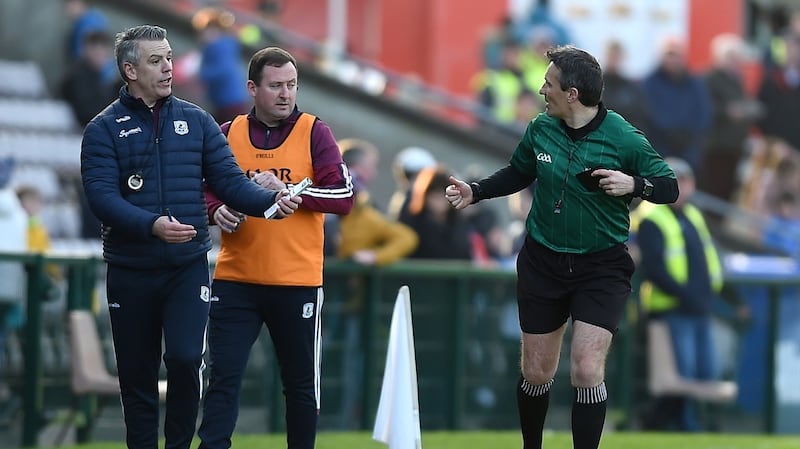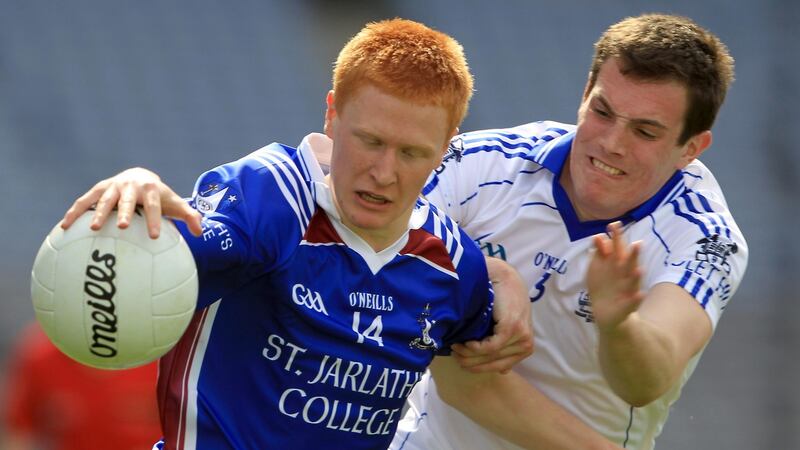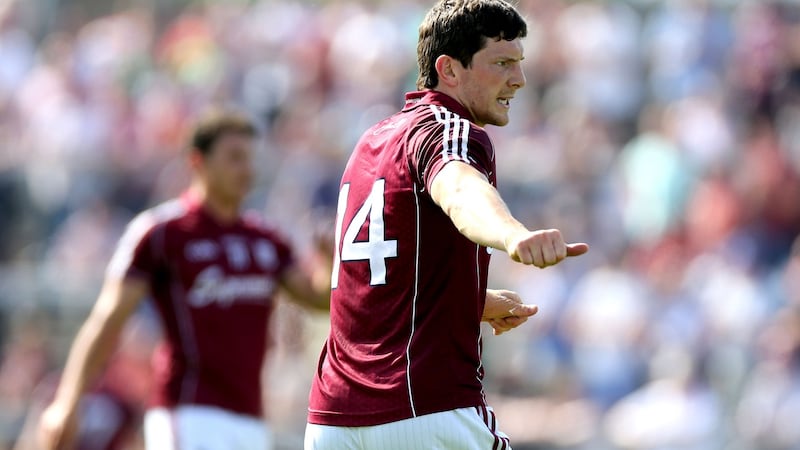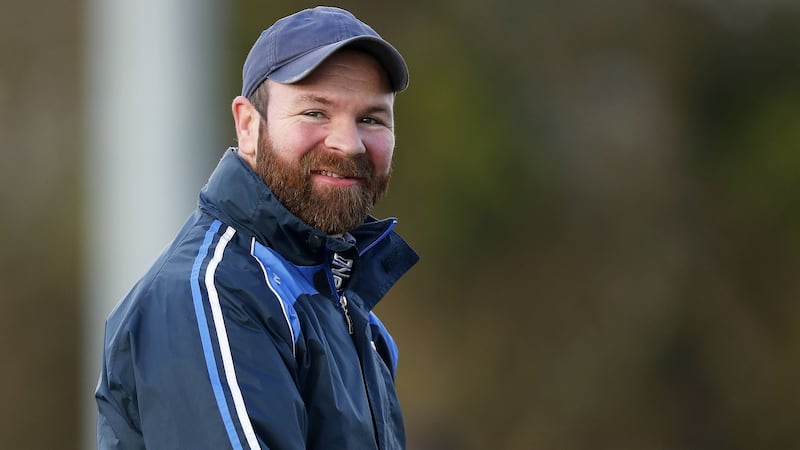“In the town of Tuam, it was almost seen as a place apart,” says John Cunningham in describing St Jarlath’s College, the sprawling boys’ school which for decades served as the unofficial furnace of Galway football.
Until Thursday’s suspension of normal civil life, the GAA fraternity across the country had throughout the league been witnessing what might be regarded as St Jarlath’s last great gift to Galway football. Throughout the league, the maroon team had excited followers and neutrals alike with a brand of flair-driven football grounded in the fundamentals.
To the tutored – and St Jarlath’s alumni everywhere – it was impossible not to link the style of play with their memory of football in the school. Manager Pádraic Joyce played on the glittering 1994 Hogan Cup-winning team along with his two selectors, John Divilly and John Concannon.
One of the incidental assets of the GAA is that it serves as a brilliant chronicler of the passing of time.
Anyone who remembers that Hogan Cup side of ’94 or the All-Ireland minor side which featured Michael Donnellan, Paul Clancy, Derek Savage, Declan and Tomás Meehan, as well as Joyce, Divilly and Concannon must wonder at the density of splendour. All except for Concannon would go on to feature in the Galway senior side which claimed the Sam Maguire in 1998.
John O’Mahony’s unbeatable trick was to fuse the best of the more senior players with the burning certainty evinced by Joyce and company. The All-Ireland club win that March by Corofin was a big part of the Galway revival.

But the role of St Jarlath’s slipped under the radar in the sense that it was all but taken for granted.
So there is something powerful in the image of the three former players on the sideline together again 25 years after their schools success. Joyce and Divilly became household names in Galway football after 1998 but when they were in St Jarlath’s, the smart money would have been on “ Scan” Concannon to be the first of that bunch to make the senior grade.
Concannon had been a sensation: 1-4 in the Hogan Cup final against St Pat’s Maghera and 1-6 in an All-Ireland semi-final against Dublin, the goal a thing of unforgettable audacity.
But it never happened. His story was best told when Christy O’Connor published, in the Irish Independent, one of those rare pieces of journalism that can be filed in the About Perfect category. This was in 2011, when Concannon was mature enough to look back with searing honesty on why he didn’t follow his friends to senior glory.
He told O’Connor about his feeling of watching the 1998 senior final from the stands. “It was pure elation after the game but driving home that evening was the biggest regret I ever had. I had so much time to think of that journey home. All sorts of things go through your head.”
On the surface, Concannon’s story is the classic GAA tale of abundant adolescent talent squandered. But he was also partially a victim of the changing pathways: he elected to go into employment after school, joining a bank whereas most of his team-mates benefited from intense football training and competition at third level. He enjoyed life. They improved. He got injured in 1997 and was cut in 1998 and finished football at 28 without playing football for Galway again.
But his friendship with Joyce remained tight and this year, he is back in a Galway dressingroom. It is almost certain that the last time the trio spent this much time together was in St Jarlath’s.

The strange thing was that the football culture in Jarlath’s benefited both Galway and Mayo. Dr John Cunningham is a past pupil of the school and a lecturer in the Department of History at NUIG. He has written the definitive book on the establishment, St Jarlath’s College Tuam 1800-2000 . It’s a social and academic treatise of the role of the school in its locality over the centuries. But it inevitably burrows fairly deeply into football.
“The primary mission, I suppose, of the place was to produce priests historically,” he says.
“But obviously they had young fellas there and had to occupy them seven days a week. And a culture of football took hold. They won the second ever Hogan Cup – 1947. I think two thirds of that team came from Mayo. And included people who played a role subsequently in 50/51 – Vincent McHale, Mick Flanagan, Seán Flanagan had attended the place a while before that. So you do find that spilling into Mayo’s success – as you did in the Galway three-in-a-row team with the Donnellans, Enda Colleran, Johnny Geraghty, Séamus Leydon . . . I mean, half the team came through St Jarlath’s.”
So what happened in Pádraic Joyce’s era was merely a replication of a rich tributary of talent gushing from the school. In retrospect, it was unlikely that any county should produce such a brilliant class of Gaelic football players. But it was absurd that they should all emerge from one school.
Michael Meehan started school just after that 1994 success and he was a key player on the last Jarlath’s team to win the Hogan Cup in 2002 before emerging as an electrifying presence on Galway senior teams until injury interrupted and prematurely finished his career after the 2017 season.
“You had the Hogan Cup winning team of ’94 and there was a big overlap on the Galway minor team that summer,” he says.

“So it was very much to the fore at that stage that there were a lot of footballers making their way to the county jersey that started off at the school. I was the last of six brothers who went to the school. We would have started off in the mid-80s. So I was always going to arrive in the door here regardless of the success in the intervening period.”
The Mayo influence in the school was pronounced throughout the century. There were about 150 boarders left during Meehan’s time as a student and he reckons that maybe 10 out of the 30 boys in his class were from Mayo.
“That would have been similar across the school so you had a good chunk of Mayo lads. Some were footballers, some were not, but they were all up for the crack.”
The school served as a kind of Checkpoint Charlie for the football and social rivalry between Mayo and Galway. It’s one of the more celebrated GAA perpetual arm-wrestles. Because of the social links between the counties, it is at once friendly and respectful and bitterly competitive. But the odd thing was that many of the players ended up knowing each other because of their time in Jarlath’s.
“I think that definitely would have been the case,” Meehan acknowledges.
“Key players over the decades from both counties. And it wasn’t that you always came face to face with your opponent, but in boarding school then there was plenty of time for chatting and learning stories. And even if you weren’t directly in the school with someone from Mayo you played against, you just had more knowledge to them . . . it just added to it.”
Meehan is a teacher in St Jarlath’s now and helps to coach the football teams there. The school has undergone a profound transition this century in that it is no longer a boarding school, merging with its rival school St Patrick’s and becoming a day school.

“It has been a massive change. There is no doubt about that. It is true to say that it was a kind of a larger family thing. And much like your club success where you have families and friends, you had that built in when you had guys that were in the school for five days a week or seven days a week until mid-term breaks. That would feed togetherness and there was nothing else to do as a boarder really except to study and play football. It was a different world in a lot of respects.
“ The football culture is still here. There is a great appetite and hunger among the students who still come in here and try to win Connacht and All-Ireland titles. Schools football in Connacht is probably more competitive than it was in the past. And clubs are getting their houses in order. There is a huge emphasis on driving those teenage years now and the bar is just higher across the province and country.”
And the end of the boarding school meant, as John Cunningham notes, an end to the infusion of Mayo blood to the school. Jarlath’s is still cut in the traditional mould but it has changed with the times too.
“Certainly, I know just last week that Margaret Atwood was a guest at the school talking to the Leaving Cert boys,” Cunningham says.
“It is an indication of the evolution of the school. Up until the 1980s, in the town of Tuam it was seen as a kind of place apart. Boarders couldn’t easily mingle in the town. So it was seen as almost a bit of Mayo in Tuam. That was kind of a perception. That it was a place apart – with a lot of Mayo people in it.”
Key figureheads loom over the Jarlath’s football story. John Cunningham cites the formidable presence of Rev Brendan Kavanagh of Annaghdown, a science teacher in the school from 1952 to 1974, succeeded by Dr Michael Mooney as Games Master. “And he brought a scientific approach to training the team.”
Joe Long was another huge figure and Fr Ollie Hughes had the distinction of being both a Hogan Cup winning player (1961) and a coach to several All-Ireland teams, including Meehan’s class of 2002. That was the last Hogan Cup the school has won to date: no other school has matched its haul of 12.
“He is still fondly remembered around here,” Meehan says of Ollie Hughes.
“I tried to bring the basic principles he gave as a coach through my playing career. And now as a coach you are repeating things that he might have said and it brings a wry smile to yourself inside your head because nobody else knows who you are quoting. But you have it inside your own head. He was very much about the basic skills of the game and there is a lot to be said for that. And I do think we have seen that even in some of the things that Pádraic and the boys are doing with Galway this year.”
Those things have, of course, been interrupted for the indefinite future. The next sighting of the Jarlath’s crew on the sideline will be a sure sign of life returning to normal again.













